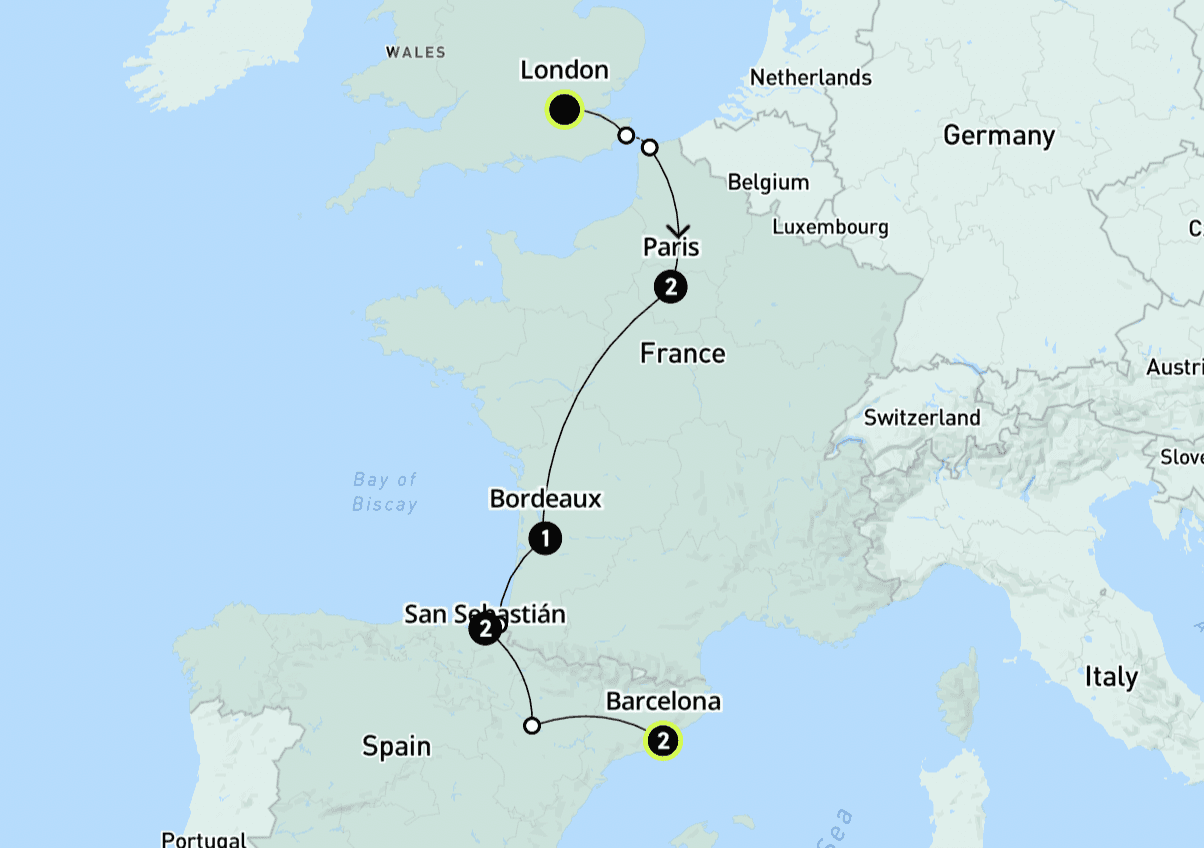Ever feel like everyone’s traveling the same way—same places, same selfies, same overpriced tourist traps?
What if I told you there’s a better way?
I’m about to share 10 travel secrets that have completely transformed my adventures—from hidden gems to simple hacks that save time, money, and a lot of frustration.
If you’re ready to turn your next trip into an unforgettable journey, you’re in the right place.
Let’s get into it!

I love tours. They’re one of the easiest, most hassle-free ways to explore a destination, meet like-minded travelers, and dive into experiences that you might miss on your own. The trick is finding the right tour for you—and I’m here to help. (I’ll also be writing a guide to my favorite tour companies, so keep an eye out for that!)
When choosing a tour, smaller groups are always a win. Companies like Intrepid Travel or G Adventures specialize in small group experiences where you can truly connect with fellow travelers. These tours tend to be more flexible, personal, and often include stops off the beaten path—no giant tour buses squeezing into crowded parking lots!
That said, everyone needs time to recharge—myself included. Whether it’s sneaking in a quick nap before dinner or enjoying some downtime with a book, don’t stress. No one has unlimited energy, and chances are, the rest of your group feels the same. It’s okay to skip a group meal or optional activity if you need some space. A little self-care can go a long way in making the trip more enjoyable.
Finally, balance is key. I like starting a trip with a short guided tour, like a city walking tour, to get the lay of the land. After that, I’ll usually plan some free time to explore solo. If you’re traveling with friends or family, set some expectations ahead of time. It’s perfectly fine to take breaks from each other to recharge—it’ll make the shared moments even better.
With the right mindset and a little planning, tours can be the perfect mix of exploration and relaxation, giving you memories (and friendships!) that last a lifetime.
When choosing a tour company, it's important to find the right balance between guided experiences and independent exploration. Learn more about tour companies in Spain.
Hack #2: Smart Money Tools
When it comes to managing travel money, Revolut is my go-to. It’s so much more than a digital wallet—it’s like having a personal travel finance assistant in your pocket. I love that I can set notifications to alert me when currency rates drop, so I can exchange money at the best rate months in advance. Plus, Revolut lets me store multiple currencies, which is a total game-changer for international trips. It means I can lock in favorable rates and avoid those last-minute conversion fees.
Speaking of fees, Revolut has some of the lowest I’ve found. Depending on your plan, you even get perks like travel insurance included—a nice safety net for unexpected hiccups. But my favorite feature? The bill-splitting tool. Whether I’m grabbing dinner with friends or booking a group tour, it makes splitting expenses hassle-free. No awkward math, no chasing people down—it’s all done within the app.
Now, if you’re someone who’s worried about overspending, consider using cash. There’s something about physically handing over money that makes you think twice about unnecessary purchases. Those “extra little treats” tend to stay on the shelf when you can literally see your funds disappearing.
For budgeting, I like to set a daily target. My sweet spot is around £150 per day, which covers everything—flights, accommodation, food, and activities. This has worked well for me, but of course, everyone’s spending habits are different. The key is to know what you’re comfortable with and stick to it. Tracking your spending daily also helps, so you don’t go overboard early in the trip and find yourself skimping later.
Whether you’re all-in on apps like Revolut or prefer old-school cash, staying on top of your travel finances makes the journey smoother—and your post-trip bank statement less scary!
Hack #3: Effortless Travel Apps
Exploring Spain is a breeze when you have the right apps in your pocket. My top pick? Omio. It’s a game-changer for comparing trains, buses, and flights all in one place. I love how easy it is to see all the options side by side, so I can pick the cheapest or quickest way to get where I’m going. Sometimes a bus beats the train on price, or a short flight can save hours of travel time—and Omio helps me spot those opportunities at a glance.
For train travel, Trainline is another excellent choice. While it focuses solely on trains, it’s super reliable and great for checking schedules and prices across Spain’s rail network. If you’re planning a trip that’s mostly train-based, it’s a handy backup to have alongside Omio.
For regional trips or those hard-to-reach destinations, BlaBlaCar is my secret weapon. It’s a ride-sharing app where locals post their routes, and you can book a seat in their car. I’ve used it to reach airports or smaller towns that aren’t easily accessible by train or bus. It’s cheap, efficient, and a fun way to meet locals. Just note that it’s best for solo travelers or pairs, as car space can be limited.
Most of the time, I combine these tools to make the most of my itinerary. Omio for variety, Trainline for trains, and BlaBlaCar for those out-of-the-way adventures. With these apps, you can focus on enjoying the journey—whether it’s cruising along Spain’s scenic rail routes or chatting with locals on your way to a hidden gem.
Using travel apps like Omio and Trainline can make transportation easier—especially when exploring Spain by train.
Hack #4: Smarter Flight Booking
Finding the best flights doesn’t have to feel like a full-time job. My go-to strategy starts with Google Flights. Their price tracker is a lifesaver—just set up an alert for your route, and you’ll get email updates when prices drop. This lets you keep an eye on deals without constantly checking yourself. A handy trick? Sometimes looking for return flights starting from the airport back home instead of your departure airport can uncover better prices or more convenient routes.

Once you’ve spotted a good deal, double-check it on Kiwi Travel. Kiwi lets you lock in that price and sometimes even gives you a better one if the cost drops further. It’s also fantastic for finding unique combinations of flights, especially if you’re open to stopovers or mixing airlines to save money.
Timing matters too. Weekends tend to be pricier, so I usually aim to fly midweek—Tuesdays and Wednesdays are often the sweet spot for cheaper fares. I also try to book flights that depart around 11 a.m. Here’s why: most accommodations have a 10 a.m. checkout and a 2 p.m. check-in. An 11 a.m. flight gives you time to leave comfortably without rushing and lands you close enough to check-in time at your next stop.
Another pro tip? Don’t forget to explore from the airport you are traveling to on Google Flights. Smaller or less obvious airports near your destination can sometimes offer much better deals. Google Flights makes it easy to check those options too. It will show you travel destinations you hadn't thought you could fly too.
By combining Google Flights alerts, Kiwi Travel, and smart timing, you can snag the best prices without spending hours searching. Travel hacking doesn’t get much simpler than this!
As a solo traveler, knowing some useful Spanish phrases can significantly enhance your confidence and safety while navigating through Spain
Hack #5: The Perfect Carry-On
If you’re looking for the ultimate carry-on backpack, the Patagonia 40L Black Hole and the Osprey Porter are two incredible options. I personally swear by the Patagonia one—it’s a duffle bag with backpack straps, making it super easy to pack and access your stuff. Whether I’m grabbing my toiletries mid-flight or pulling out my laptop for airport security, it’s a breeze to get in and out of. Plus, Patagonia is a not-for-profit company, and they’ll repair your gear for free if it ever gets damaged (though mine has never needed it!). Best of all, it fits perfectly in carry-on, saving you tons on baggage fees.

If comfort is your priority, the Osprey Porter is worth considering. A few of my friends swear by it for its superior back support, especially on longer travel days. While it’s slightly less accessible than the Patagonia for quick packing and unpacking, it’s still a fantastic, reliable option for carry-on travelers.

Now, let’s talk packing. The trick is to pack light and pack smart. I recommend bringing 1–2 outfits you absolutely love—you can always wash as needed. Keep your essentials simple, and leave room for anything extra you might pick up along the way. I’ve included a sample packing list in PDF format (with space for notes) to make it even easier to stay organized.
With either of these bags, you’ll travel lighter, smarter, and more comfortably. Whether you choose the functional ease of the Patagonia or the ergonomic comfort of the Osprey, you’re setting yourself up for stress-free, budget-friendly travel.
Packing efficiently is key to stress-free travel. Here’s a guide on what to pack for Spain in September.
Hack #6: Outsmart Airlines
If there’s one travel hack I swear by, it’s using AirTags for your luggage. Airports and airlines do their best, but let’s be honest—bag tracking isn’t their strong suit. I’ve had friends stuck at service desks while their bags were sitting in Germany, and they were in France! With an AirTag in your suitcase, you’ll always know exactly where your bag is, even if the airline doesn’t. Trust me, it’s a total lifesaver, especially during hectic travel seasons.
Now, let’s talk flights. It still amazes me how I can often snag a flight that’s cheaper than the train ride to the airport. The key is understanding the rules and strategies to avoid extra costs. For instance, if your flight gets canceled, airlines generally have to compensate you for delays over 24 hours (depending on where you are and the airline’s policies). A short reschedule of a couple of hours? That’s usually fine, but don’t let anyone pressure you into paying extra for a new flight—especially at the airport desk. If you book a new flight on your own, you lose the original ticket value, and airport desks won’t match those discounted online fares. It’s all based on booking class, and high demand means higher prices no matter if you are in Business Class. They will not compensate you for paying to go on an earlier flight.
Here’s a tip: If your flight is canceled and rescheduling doesn’t work, consider staying an extra day and flying out tomorrow. I’ve done this before, and not only has it been cheaper, but it’s also given me an unexpected bonus day to explore. A win-win, really!
The takeaway? Always travel with an AirTag in your bag and know your rights when it comes to flight changes. Whether it’s tracking your luggage or saving money on flights, these simple steps can make a huge difference in your travel experience.
Hack #7: Break the Ice
One of the easiest and most rewarding ways to connect with people in Spain is to try speaking the language. Locals love it when you make an effort—even if your Spanish is limited to a few basic phrases. And don’t worry about the regional dialects like Catalan, Basque, or Galician. A simple "hola" or "gracias" will go a long way, and most people genuinely appreciate your effort. If someone doesn’t? That’s on them, not you!
If you’re looking for tools to help, DeepL Translate is an absolute game-changer. It’s more accurate than Google Translate for many languages, especially Spanish, and can help you phrase things naturally. For serious learners, though, I can’t recommend Baselang enough. It’s hands-down the best way to learn Spanish quickly and effectively. You get unlimited one-on-one lessons with native speakers, which is perfect for building confidence before your trip. If you’re committed to learning, it’s worth every penny.
And here’s the best part: you don’t need to be fluent to make an impression. Even 10 minutes a day practicing key phrases before your trip can make a difference. Start with greetings, ordering food, and asking for directions—practical phrases you’ll actually use. I have compiled a list to help you: "17 Key Spanish Phrases".
If you slip up? Laugh it off! People remember enthusiasm and kindness far more than any grammar mistake. Plus, trying to speak the language often leads to memorable moments—like a local teaching you a new phrase or sharing their favorite tapas spot.
So, whether you’re using DeepL for quick translations, Baselang to level up your Spanish, or just diving in with a smile and a "buenos días," speaking the language is your ticket to connecting with locals and making your trip even more special.
Hack #8: Private Rooms in Hostels
Traveling solo doesn’t mean sacrificing comfort—or your budget. One of the best options for solo travelers is booking a private room in a hostel. It’s the perfect balance of social interaction and personal space. You get to meet like-minded travelers in common areas without having to share a dorm room (and risk listening to late-night snorers or the dreaded 5 a.m. zipper noise).
Hostels have come a long way, and many now offer cozy, affordable private rooms that rival budget hotels. Websites like Hostelworld or Booking.com make it super easy to filter for private room options, so you’re not stuck scrolling through endless dorm listings. You’ll often find private rooms with shared bathrooms, but in many hostels, en-suite options are available too.

Why hostels over hotels for solo travelers? It’s all about the atmosphere. Hostels are designed for connection. From communal kitchens to group activities like pub crawls or walking tours, they’re great for meeting people. You can chat with fellow travelers over breakfast, share tips on hidden gems, or even find a buddy for your next day trip—all while knowing you’ve got your own space to retreat to when you need a breather.
Another perk? Hostels are often located in prime areas, close to major attractions and public transport, making them a convenient base for exploring. They’re also typically cheaper than hotels, leaving you more room in your budget for experiences.
So, if you’re traveling solo and want the best of both worlds—your own room plus a built-in social scene—private rooms in hostels are the way to go. Trust me, it’s the perfect setup for making friends, recharging after a busy day, and enjoying the freedom of solo travel.
Hack #9: Find Hidden Gems
Uncovering hidden gems while traveling has never been easier, thanks to tools like Instagram and Mapstr. If you’re like me and love exploring beyond the typical tourist spots, these apps can be your best travel companions.
First, let’s talk about Instagram. The location feature is a goldmine for discovering unique places. Just search for your destination and scroll through tagged posts—you’ll often stumble upon stunning cafes, lesser-known viewpoints, or quirky attractions that don’t make it into guidebooks. It’s especially great for finding restaurants or bars that locals love, as travelers often share their favorite finds in real-time. Bookmark your discoveries to create a visual to-do list!
Pair this with Google Maps for a practical edge. One of my favorite hacks is using Google Maps to look for busy areas—it highlights them in yellow. When booking accommodations, aim to stay near these spots for easy access to vibrant neighborhoods with lots to see and do. But don’t limit yourself to just the yellow zones; they’re great for energy, but quieter areas often hold the real treasures.

For a more organized approach, Mapstr is a game-changer. It’s an app that lets you save, categorize, and share all your favorite spots on a personal map. I’ve created entire itineraries with it, and the best part? You can easily share your map with friends or fellow travelers. I also have a curated collection of local restaurants, guides, and hidden gems accessible via my newsletter—be sure to check it out below!
By combining Instagram’s inspiration, Google Maps’ insights, and Mapstr’s organization, you’ll uncover incredible places that might otherwise be missed. Your next favorite hidden spot could be just a few clicks away!
Hack #10: Stay Connected
Staying connected while traveling is a must, but not all mobile plans work seamlessly overseas. If you’re like me and prefer hassle-free communication, a reliable travel SIM is the way to go. My top choice? SIM Corner. Unlike eSIMs, it provides a physical SIM card that allows you to make actual phone calls—perfect for booking restaurants, connecting with people you meet on the go, or even calling local services. Having this option has saved me countless times when Wi-Fi wasn’t an option or when people don't use social media apps.
While eSIMs are convenient for their instant setup, they rely entirely on data packs. This means you’re often draining your data faster than expected through social media, WhatsApp calls, or navigation. It’s a great backup if you’re a light data user, but for someone who likes making direct calls, SIM Corner is a lifesaaver. Plus, it’s super easy to order and activate before your trip, so you’re connected the moment you land. I also find the eSIMs go out of range quite quickly compared to traditional SIMs.
A great option for esim is Airalo or Holafly, especially for short trips or if you only need data. Airalo and Holafly offer a wide range of eSIM plans for different countries and regions, making it a flexible choice. It’s perfect if you just need Google Maps, email, or social media access without worrying about topping up.
Both options have their strengths, but if you’re planning to call ahead for reservations, tours, or even chat with new friends, a physical SIM card like SIM Corner is worth it. No matter which route you take, staying connected ensures smoother travel, from checking last-minute bookings to keeping in touch with loved ones back home.
Make sure your travel documents are in order before departure by reading up on ETIAS 2025 FAQs.
Share Your Hacks!
From finding cheap flights with Google Alerts to using AirTags, navigating with Omio, packing light and staying connected with SIM Corner.
We’ve covered hacks to make your travels smarter and smoother.
Have a favorite tip we missed?
Share it—we’d love to hear your go-to hacks!
FAQS Travel to Paradiso
Recent Posts
















